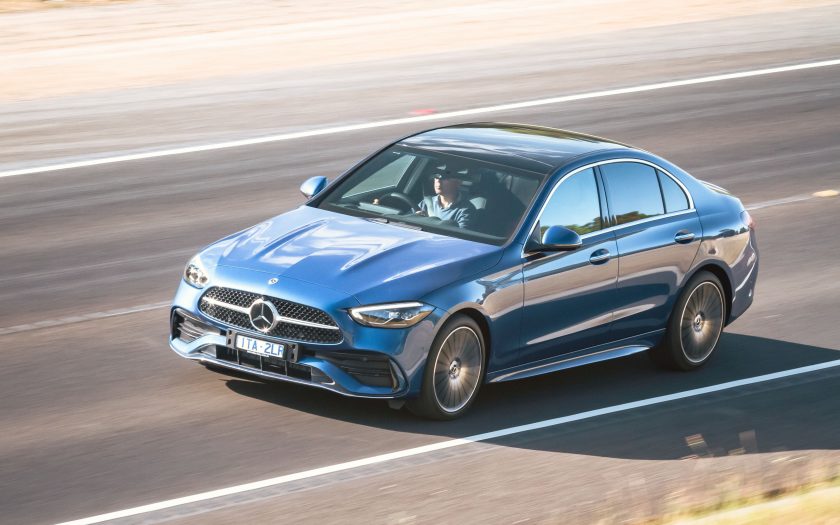Chris Riley tests the 2023 Mercedes-Benz C300 with pricing, specs, ride and handling, safety, verdict and everything the over-50 driver needs to know.
Summary: Many people won’t even look at other alternatives unless they are European. But the BMW 320i is built in Mexico, the South Korean Genesis is a strong contender, and Mercedes-Benz don’t shout about it, but the C-Class is built in South Africa.
2023 Mercedes-Benz C300 sedan
Pricing: $93,500 (plus on road costs)
Options: Vision Pack $3800, Cavansite Blue Metallic paint $1600
Warranty: Five-years/unlimited km
Safety: 5-star ANCAP (tested 2022)
Build location: South Africa
Engine: 2.0-litre 4-cylinder turbo intercooled DOHC petrol
Power: 190kW at 5800rpm
Torque: 400Nm at 3200rpm
Transmission: 9-speed automatic, rear-wheel drive
Body: 4755mm (long); 1820mm (wide); 1450mm (high)
Weight: 1573kg
Towing capacity: 1800kg
Wheels: 19-inch alloy
Tyres: 225/40 R19 (front), 255/35 R19 (rear)
Ground clearance: 118mm
Turning circle: 11.2m
Fuel tank capacity: 66 litres
Official consumption: 7.3L/100km (98 RON petrol)
Consumption on test: 12.0L/100 (900+km)
seniordriver consumption on test: not tested
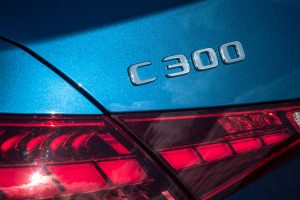
[review]
C-Class has been the mainstay of the Benz range for years.
And despite the popularity and growing number of SUVs, it continues to shine as the biggest seller in a range that now comprises more than 20 models.
Diversity has kept the car relevant, with a sedan, coupe, wagon and convertible available, along with various power trains including the sledgehammer 500kW AMG C 63 S 4MATIC+ sports sedan.
It all comes together in a heady, amazing mix of style and technology which will take your breath away. So could the price – up to $15,000 more than the previous model.
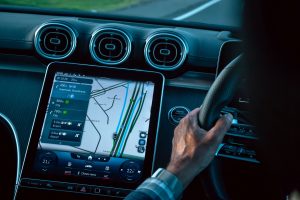
What’s it cost?
Prices start from $81,700 for the C 200 Sedan.
Our test vehicle, the more expensive, more powerful C300 sedan, is priced from $93,500 plus on-roads.
But that’s not the end of the story with a mind-boggling list of options and – just quietly – not many Benzs leave the dealership without at least some of the boxes ticked.
The process can see the price of the car rise quickly and dramatically – none are strictly necessary however.
The test car was fitted with the $3800 Vision Pack plus Cavansite Blue Metallica paint at $1600, taking the price to $98,900.
The pack adds a sunroof, seat memory and heating, head-up display, traffic sign recognition and augmented reality for navigation.
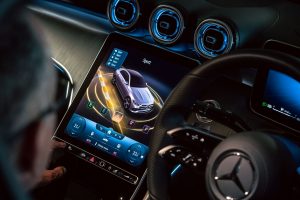
Once upon a time, C-Class came with a choice of classic or dynamic styles, with a different radiator to match.
Now the AMG Line exterior package is standard and comes with a body kit and bold new diamond grille with star design in chrome (little Benz three-pointed stars).
LED headlights include headlight assist and adaptive high beam assist, while the optional digital light package uses 1.3 million micro-mirrors per headlight for extremely high-definition output.
The rear-end features new tail lights with a two-piece design, with light functions divided between the outside and boot-lid lights.
Three optional new paint finishes – Spectral Blue, High-Tech Silver and Opalite White – have been added to the colour palette.
The instrument panel has become a free-standing, 12.3-inch high-resolution that sits behind the wheel, with a variety of colours and configurations from which to choose.
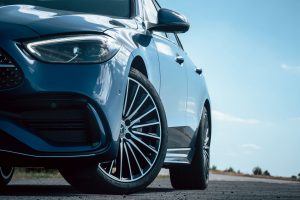
Australian models reportedly benefit from a higher level of standard equipment, including a number of features that were previously unavailable or optional.
Features include AMG Line exterior and interior packages, 11.9-inch central media display, 360-degree camera, keyless entry and start with automatic powered boot closing, front centre airbag, fingerprint scanner and active safety systems including adaptive cruise control.
C300 adds a more powerful drivetrain, with full leather trim, larger 19-inch AMG multi-spoke two-colour alloys and rear privacy glass.
Inside there’s sporty AMG Line trim and floor mats, plus 64-colour ambient lighting, an illuminated front door sill with ‘Mercedes-Benz’ lettering, keyless entry and start and dual-zone climate control.
The second-generation Mercedes-Benz User eXperience (MBUX) infotainment system is a stunner, fronted by an 11.9-inch, portrait-style touchscreen.
It includes Bluetooth, voice recognition, built-in navigation, AM/FM and DAB+ digital radio, plus wireless Apple CarPlay and Android Auto.
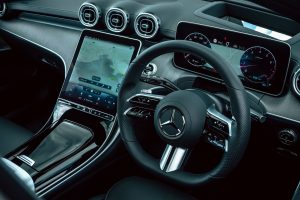
When following the navigation, a forward-facing camera creates an augmented view on the centre screen, which is basically video of the road ahead with an arrow superimposed to follow.
The display includes an ergonomically placed fingerprint scanner for secure and easy access to different profiles.
You can also access the infotainment system via a console-mounted touchpad, or track pads embedded in the multi-function sports-styled steering wheel.
There are two USB-C ports in the centre console and another at the bottom of the dashboard next to the wireless charging pad – but none in the back.
There’s no mention of the audio system, either in the sales brochure, specifications or technical data.
Guess it’s generic or perhaps another victim of the global components shortage.
At this price, you’d expect and demand a name brand.
A comprehensive standard safety suite includes 10 airbags, including a centre-front airbag for the first time.
Autonomous emergency braking (Car-to-Car, Vulnerable Road User, Junction Assist and Backover) as well as a lane support system with lane keep assist (LKA), lane departure warning (LDW) and emergency lane keeping (ELK), and an advanced speed assistance system (SAS) are standard.
There’s also adaptive cruise control, drowsiness monitoring, a 360-degree camera and active parking assistance with park sensors.
C-Class is covered by a 5-year unlimited kilometre warranty.
Service is due every 12 months or 25,000km and the first five years will set you back $5200.
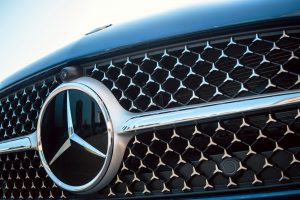
What’s it go like?
At 4793mm in length, the C-Class is 107mm longer than before, with a 25mm longer wheelbase, which in theory means more room inside.
Entry C200 is powered by a 150kW 1 .5-litre turbo hybrid.
“Our” C300 gets a larger more powerful turbocharged petrol engine together with an electric motor/48-volt starter-generator sandwiched between the engine and transmission that provides up to 15kW and 200Nm at low speeds.
The hybrid system is designed to provide assistance at low engine speeds and to provide significant fuel savings, but it cannot be driven in electric-only mode.
It’s paired with a nine-speed automatic transmission and delivers 190kW of power at 5800 rpm and 400Nm of torque between 2000 and 3200 rpm, with overboost providing an extra 20kW briefly.
Drive is to the rear wheels, with paddle shifts, auto engine stop-start and four drive modes available.
The dash from zero to 100km/h takes a brisk 6.0 seconds.
It takes the good stuff too, premium 98 unleaded, with fuel consumption a claimed 7.3L/100km.
The interior of the C-Class is a masterclass in style and technology.
There are elements of the old, the in-between and the new emerging age.
The eye-catching Tesla-style vertically mounted touchscreen flows seamlessly into the centre console.
Did I say eye-catching? If it wasn’t for the second smaller screen that replaces a conventional instrument panel, it would dominate the cabin.
At night the whole thing lights up like a Christmas tree. In fact, it could be a little too over-the-top, especially for techno-challenged pre-millennials.
It could do with an off switch.
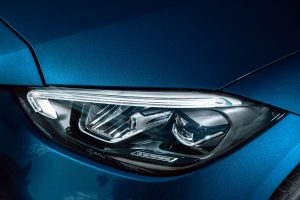
Touch sensitive controls (they’re found everywhere) are tricky to operate and functions can be difficult to find – the trip computer is a case in point.
The column-mounted gear lever is something of a throwback, but it’s easy to operate and paves the way for the clutter-free console.
At the same time, we were left wondering what would happen if one accidentally selected reverse while driving, thinking it was the indicator stalk?
We weren’t game to find out (but there must be some kind of lockout).
The back seat is deep and inviting, but is surprisingly lacking for legroom, even though this model has a slightly longer wheelbase.
Those in the back get air vents and a fold down centre armrest, but little else to speak of – charge ports would be nice?
The boot is a good size at 455 litres and has a power operated boot lid.
Arriving home for the first time the car slammed on the brakes, believing we were about to run into the back of the car already in the driveway.
We must have been going a little too quickly for the system – it scared the bejesus out of us.
A button at the end of the gear lever puts the car into Park, but it’s not clear whether this engages the electric parking brake – the indicator comes on only when you turn off the car.
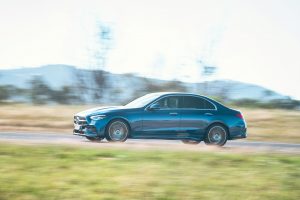
Back on the road, the drive experience is cruisy and comfortable, apart from some tyre noise and tyre slap from time to time depending on the road surface.
Choosing the appropriate drive mode is accomplished via a toggle to the left and below the touchscreen air controls.
Sport and Sport+ amp up the drive experience, but the transmission dozes off and tends to lag when you ask it the question, as it drops down a gear or two.
This was especially obvious when it came to overtaking.
Punch the accelerator and the car fails to respond immediately and it becomes necessary to pull back in again. Bugger!
A switch to manual mode and using the shift paddles to change gears rectifies this situation.
Although the suspension has been lowered, it’s still a bit soft and bouncy to be called really sporty and bottoms out easily.
The steering is nicely weighted but the brakes are over sensitive. Just a dab is required. Applying what we consider a normal amount of pressure elicits an abrupt response.
Overall, it is a car better suited to touring than race tracks and that is exactly what it is designed to be.
In terms of fuel consumption, we were getting a long term 12.0L/100km after more than 900km and 8.2L in the short term – nowhere near the 7.3L promised.
Oh, and a tyre repair kit is provided in lieu of a spare tyre.
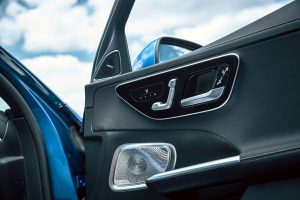
What we like
- Looks fantastic
- A techno smorgasbord
- Good-sized boot
What we don’t like
- Laggy throttle response
- Touchy brakes
- Heavy fuel consumption
- Limited rear legroom
- Needs an off switch for all the lights
- Even the air vents are back lit
What over-50s drivers need to know
It’s good, but all that glitters isn’t necessarily gold.
There’s no physical volume knob, no-name audio and navigating the infotainment system can be a challenge – especially underway.
The engine is a bit disappointing too, both in terms of performance and fuel consumption.
But it’s got the badge and is pretty comfy, and it will make short work of long hops between cities and interstate.
For this kind of money, however, the C300 needs to tick all the boxes – and frankly, it doesn’t.
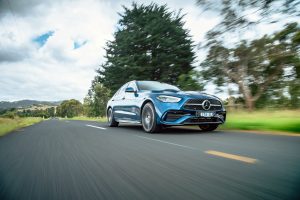
seniordriver comments
When the C-Class was launched in New Zealand many years ago, a number of the more (ahem!) senior journalists commented that they “had discovered the car they would buy when they retired”. Judging by the enduring popularity of the small Benz sedan, they weren’t the only ones.
Like most models in the increasingly diverse M-B range, you can choose from mild to wild. The only thing you can’t specify is “affordable” – that $15,000 price hike is very hard to swallow. But everything is relative.
Mercedes-Benz has standardised a lot of features across its range (we were always told, on Mercedes-Benz launches, that what is standard in the S-Class will be standard in the A-Class a few years down the track). While that’s great for buyers of lesser M-Bs, we wonder how those spending twice or three times as much feel about it.
The lack of a brand-name sound system is a little surprising, but notwithstanding, we doubt many buyers will have reason to complain about the quality of the system.
While Chris comments that the touch sensitive controls can be tricky to operate, feedback we get suggests they quickly become second nature. As for the column-mounted gear lever, it really is far too easy to mistake it for the indicator wand, especially if you are unfortunate enough to have to change between cars with the indicator on different sides. We’ve all activated the wipers when we meant to indicate a turn – that’s a lot less fraught than flicking the car into Reverse or Park. We’re checking, but we haven’t heard of anyone actually doing that, so there probably is some sort of lockout.
We can also advise that the parking brake is automatically engaged when you select Park (and automatically disengages when you select Drive).
Actual fuel consumption falls a long way short of the claimed 7.3L/100km.
Once again, it is disappointing that there is no physical volume knob for the infotainment system, and it takes some time to navigate through the various menus (and even longer to learn them) when you want to make a simple adjustment.
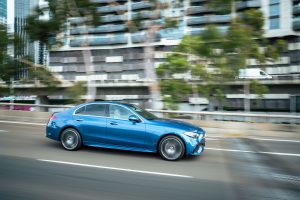
Talking about alternatives is probably futile. Buyers of luxury cars are welded on to their favourite brand and probably won’t even consider alternatives. That’s a pity because there are some excellent cars in this class, and some of them will deliver substantial savings. We’ll throw six at you, for starters: the Genesis G70 Sport (with spritely performance thanks to its larger 3.3-litre engine, but a corresponding penalty at the fuel pump); naturally, you’ll want to consider the equivalent BMW (the 320i) for $78,900 plus on road costs, and the Audi A4 45 TFSI quattro S-Line (which, like some on our list, comes with all-wheel drive); also worth a look is the Lexus EX F Sport (from $71,390 plus on road costs); the Jaguar XE 300 Sport (from $80,450 plus on roads) has the added assurance of all-wheel drive; and one model we’d strongly suggest considering is the almost overlooked Volkswagen Arteon 206TSI R-Line, which also gets all-wheel drive, starts from $72,390 (plus on roads) and in many ways is superior to the Benz – except for the badge, of course.
